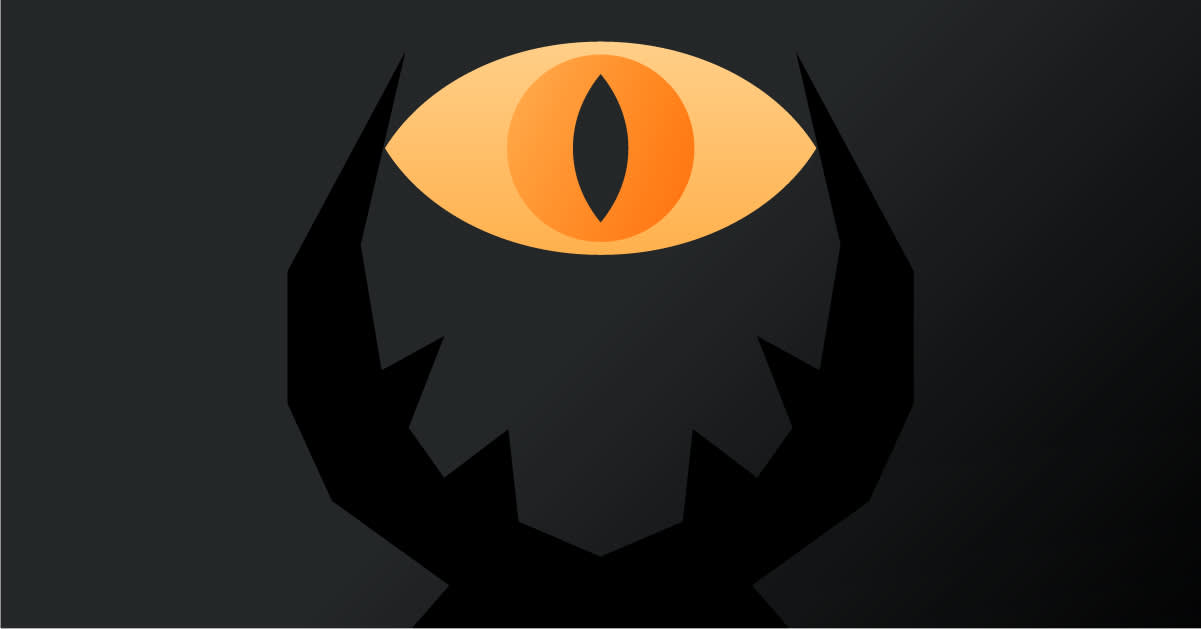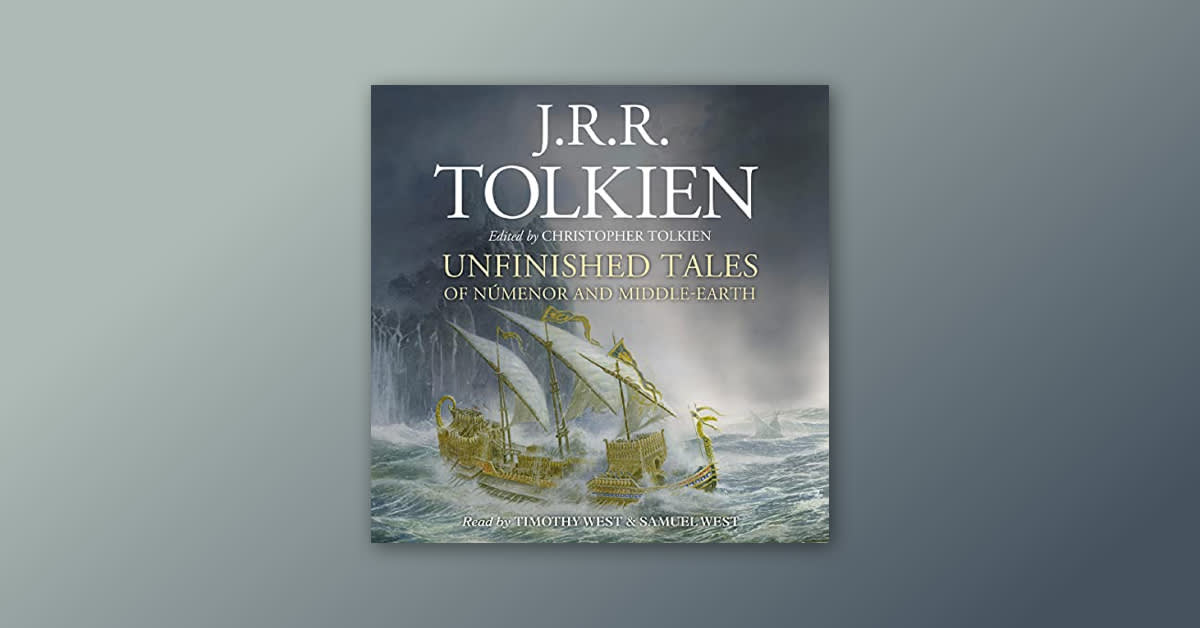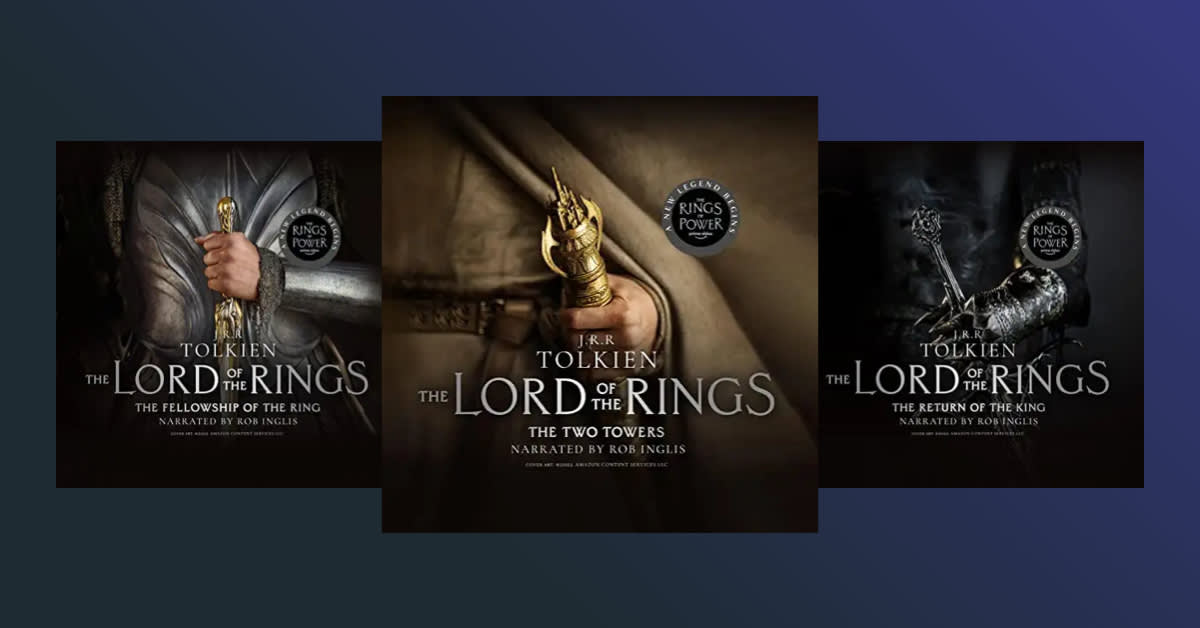Who is the titular "Lord of the Rings" in the famed tale by J.R.R. Tolkien? Simply put, it’s Sauron, the trilogy's primary antagonist and the one who forged the One Ring to Rule Them All in the fires of Mount Doom. Though Sauron is storied throughout Tolkien’s lore and mythos, we likely haven’t seen the last of him yet. Prime Video's upcoming The Lord of the Rings: The Rings of Power takes place during the Second Age and follows the story of the forging of the Rings of Power, so it’s possible that Sauron may play a significant role in the story.
So, how—if at all—will Sauron factor into the highly anticipated streaming series? The details are still mysterious. But here's what we already know about the powerful and evil Sauron—his character, his history, his powers, and more.
Who is Sauron?
Throughout the years, Sauron has taken on many roles and gone by many names. He is the eponymous Lord of the Rings, the Dark Lord, but his other names have included Mairon, Annatar, Artano, Aulendil, Gorthaur, and Zigûr. He's also identified as the Necromancer in The Hobbit.
Tolkien never describes Sauron's physical traits in detail in his novels. Sauron was initially able to shift his appearance, but when he became a servant of Morgoth, he took on a sinister form that Tolkien described in his letters as slightly bigger than human stature yet not giant. This version of Sauron had daunting eyes and appeared as malice and hatred incarnate. Sauron has also taken on the shape of a werewolf, a serpent, and, in attempts to charm and manipulate others, a beautiful, alluring creature.
Then there is the Eye, the image most associated with Sauron during The Lord of the Rings series. The Eye of Sauron is also called the Great Eye, the Eye of Barad-dûr, the Red Eye, the Lidless Eye, and the Evil Eye. Sauron's symbol of a lidless eye became an image that instilled fear across Middle-earth during the Third Age. It's unclear whether the Eye is actually Sauron himself or whether he is embodied beyond the eye. But no matter—the Eye represents Sauron's evil.
But is Sauron a being of pure, irredeemable evil? “In my story Sauron represents as near an approach to the wholly evil will as is possible," Tolkien explained in his letters. "He had gone the way of all tyrants: beginning well, at least on the level that while desiring to order all things according to his own wisdom he still at first considered the (economic) well-being of other inhabitants of the Earth. But he went further than human tyrants in pride and the lust for domination." So, even if Sauron is not pure evil per se, he is greedy, cunning, and thirsty for power—and he's willing to cause great harm and destruction to get what he wants.
Sauron Through the Ages
Sauron in the Years of the Lamps
Sauron was the most powerful of the Maiar—primordial spirits created to help the Valar first shape the World. His original name was Mairon, which means "the Admirable," and as an immortal spirit born before the world's creation, he was able to perceive the Creator Eru Ilúvatar directly. At first, Mairon was good and uncorrupted, and he spent his time learning about craftsmanship from Aulë. But when the Vala Melkor (later known as Morgoth) rebelled against Eru, the evils of the world were created. Melkor sought to destroy Middle-earth, and Mairon wanted to control it. So, Mairon allied with Melkor, becoming his chief servant.
Sauron in The First Age
At first, Mairon remained among the Valar, secretly spying on them and feeding information to Morgoth. With the information Mairon gave him, Morgoth was able to destroy Almaren, the dwelling-place of the Valar. The Valar then moved to the Blessed Realm of Valinor, not knowing that it was Sauron who had betrayed them. But at this point, Sauron was ready to leave the Blessed Realm and officially join Morgoth's ranks in Middle-earth. The Sindar Elves in Beleriand gave Mairon the name Gorthaur, meaning "dread abomination," while others called him Sauron, meaning "the abhorred" or "the abominable," a play on his original name. Morgoth and his followers waged war on the Valar and on the Elves. It was during this time that Sauron battled the Elven maiden Lúthien and Huan the Wolfhound. Sauron took on the form of a werewolf to fight them, but when it became clear that he was losing the battle, he transformed into a giant vampire bat and flew away. In the War of Wrath, Morgoth was defeated and cast into the Outer Void beyond the world. Sauron, however, was able to escape.
Sauron in The Second Age
After remaining hidden for five centuries, Sauron reappeared. With the intention of taking over Middle-earth, he named himself the next Dark Lord. By SA 1000, Sauron had established a stronghold in the land of Mordor in eastern Middle-earth. There, he began building the dark fortress Barad-dûr near Mount Doom. With his powers of manipulation and cunningness, Sauron quickly lured followers, soon amassing armies of Orcs and Trolls. He was also able to sway many nations of Men, such as the Easterlings and Haradrim, to his side. Next, Sauron sought to bring the Elves into his service, so he disguised himself as Annatar, Lord of Gifts, to seduce them. The Elves helped Sauron forge the Rings of Power. In secret, Sauron also forged the One Ring, to rule all other rings, in the fires of Mount Doom in Mordor. But when the Elves discovered the power of Sauron's One Ring, they removed their own Rings of Power. Sauron was enraged, and he initiated a war against the Elves. He demanded that all Rings of Power be given to him. The Elves were able to hide the three strongest rings from Sauron, but 16 other Rings of Power ended up in Sauron's hands. Sauron gave seven of the Rings to Dwarves, who remained resistant to their powers, but the Rings did foster in the Dwarves feelings of greed and an insatiable lust for gold. The nine other Rings went to Humans, who were indeed corrupted by the powers of the Rings. These nine Men became the Nazgûl, or Ringwraiths, Sauron's most dreaded servants. At the end of the Second Age, Sauron was defeated by Isildur, who was able to cut the Ring from Sauron's hand. Isildur was then urged to destroy the Ring by casting it into Mount Doom, which would have banished Sauron from Middle-earth forever. But charmed by the Ring's powers, Isildur was unable to destroy it, leaving a window for Sauron's return.
Sauron in The Third Age
As long as the Ring existed, Sauron could not truly be defeated, and so for many years, he remained dormant, a non-corporeal, shapeless evil. After Isildur died in battle trying to use the One Ring, it went missing. Eventually, it was discovered in the River Anduin by a Hobbit named Déagol. When his cousin Sméagol saw the Ring, he became uncontrollably jealous and killed Déagol to get the Ring for himself. Banished for his crimes, Sméagol went to hide in the Misty Mountains with his precious Ring, and there he became the deformed, corrupted creature known as Gollum. Around this time, Sauron had reestablished himself in the south of Mirkwood as the Necromancer. At first, the Elves did not realize the threat in Mirkwood was Sauron himself and instead believed it was a Nazgûl. Eventually, Gandalf the Gray uncovered that the Necromancer was in fact Sauron, and the White Council drove him from Dol Guldur. Sauron retreated back to Mordor, where he officially declared himself master and began rebuilding his armies to overtake Middle-earth once and for all. In TA 3017, Gandalf discovered that the Ring was now in the hands of the Hobbit Bilbo Baggins, who passed it down to his nephew, Frodo. Gandalf helped Frodo travel to Rivendell, where they established the Fellowship of the Ring, nine brave souls who would travel to Mount Doom to destroy the Ring, thus destroying Sauron. The wizard Saruman attempted to take the Ring from Frodo, but his army was destroyed and his stronghold at Isengard was overthrown. In the final battle of the War of the Ring, the Battle of the Morannon, Aragorn led the Army of the West, and they distracted Sauron while Frodo Baggins and Samwise Gamgee attempted to destroy the Ring. But at the last minute, Frodo was overtaken by the powers of the Ring and claimed it as his own. At that moment, Gollum, who had followed Frodo and Sam, attacked Frodo, stole the Ring, and then fell into the volcanic Mount Doom, destroying the Ring in its fires and ending the reign of Sauron for good.
Sauron's Powers and Abilities
As the mightiest of the Maiar, Sauron acquired much knowledge about the world's substances and how to use them, which would help him forge the One Ring and construct his fortress. Sauron was also extremely well-versed in the powers of manipulation, deception, and disguise. Throughout the First Age, Sauron took on many different forms. His powers of deception were so strong that, under the disguise of the beautiful Annatar, Sauron was able to convince the Elves to help him forge the Rings of Power. Additionally, Sauron was a powerful sorcerer, capable of necromancy, among other forms of dark magic.
Sauron's Allies and Enemies
Aulë
At the beginning of time, Aulë was responsible for crafting all of the substances that made up the world of Arda. Under Aulë's mentorship, Sauron learned the powers of smithing and handiwork that would later allow him to forge the One Ring. When Sauron sought to corrupt the Elves in the Second Age, one of the names he called himself was Aulendil, which means "devotee or friend of Aulë."
Morgoth
Morgoth was the first Dark Lord, and Sauron was his most loyal servant in the First Age. While the two were allies, their goals were different. Morgoth sought to destroy Middle-earth, which Sauron sought to control.
Saruman
Saruman, also known as Saruman the White, is the one Istari Sauron was able to lure into his service. While Saruman was Sauron's ally, the Wizard had the ultimate goal of taking the Ring and wielding its powers for himself.
Smaug
Smaug was considered to be the last "great" dragon of Middle-earth. Sauron allied with Smaug and intended to use the dragon's powers against the people of Middle-earth. But before that could happen, Smaug was slain by Bard the Bowman.
Grishnákh
Grishnákh was an Orc captain of Barad-dur in Mordor, under command of Sauron.
Isildur
At the end of the Second Age, Isildur was able to defeat Sauron by cutting the Ring from his hand. However, Isildur was too enthralled by the power of the Ring to destroy it, and Sauron was able to come back into power in the Third Age.
Aragorn
Aragorn leads the attack against Sauron in the War of the Ring. Aragorn is the descendant of Isildur, so Sauron mistakenly believes the Ring is in Aragorn's hands. Thus, Aragorn is able to distract Sauron while Frodo destroys the Ring.
Frodo Baggins
As the bearer of the Ring, Frodo carries the Ring to Mount Doom in order to destroy it—and thereby destroy Sauron and his evil powers.
Galadriel
When Sauron comes to the Elves as Annatar, Galadriel is one of the only ones wise enough not to trust Sauron's disguise. When the Elves discover Sauron's true intentions with the Rings of Power, Galadriel keeps and hides one of the three most powerful Rings.
Gandalf
Gandalf is one of the Istari who was sent to Middle-earth to protect its people from the threat of Sauron. He is the leader of the Fellowship of the Ring, who traveled to Mordor with the intention of destroying the Ring.
Best Sauron Quotes
"Now Sauron's lust and pride increased, until he knew no bounds, and he determined to make himself master of all things in Middle-earth, and to destroy the Elves, and to compass if he might, the downfall of Númenor. He brooked no freedom nor any rivalry, and he named himself Lord of the Earth. A mask he still could wear so that if he wished he might deceive the eyes of Men, seeming to them wise and fair. But he ruled rather by force and fear, if they might avail; and those who perceived his shadow spreading over the world called him the Dark Lord and named him the Enemy; and he gathered under his government all the evil things of the days of Morgoth that remained on earth or beneath it, and the Orcs were at his command and multiplied like flies." —The Silmarillion
"Alas, for the weakness of the great! For a mighty king is Gil-galad, and wise in all lore is Master Elrond, and yet they will not aid me in my labours. Can it be that they do not desire to see other lands become as blissful as their own? But wherefore should Middle-earth remain for ever desolate and dark, whereas the Elves could make it as fair as Eressëa, nay even as Valinor? And since you have not returned thither, as you might, I perceive that you love this Middle-earth, as do I. Is it not then our task to labour together for its enrichment, and for the raising of all the Elven-kindreds that wander here untaught to the height of that power and knowledge which those have who are beyond the Sea?" —Sauron as Annatar, —The Silmarillion
"Now the Elves made many rings; but secretly Sauron made One Ring to rule all the others, and their power was bound up with it, to be subject wholly to it and to last only so long as it too should last. And much of the strength and will of Sauron passed into that One Ring; for the power of the Elven-rings was very great, and that which should govern them must be a thing of surpassing potency; and Sauron forged it in the Mountain of Fire in the Land of Shadow. And while he wore the One Ring he could perceive all the things that were done by means of the lesser rings, and he could see and govern the very thoughts of those that wore them." —The Silmarillion
"But Sauron was not of mortal flesh, and though he was robbed now of that shape in which he had wrought so great an evil, so that he could never again appear fair to the eyes of Men, yet his spirit arose out of the deep and passed as a shadow and a black wind over the sea, and came back to Middle-earth and to Mordor that was his home. There he took up again his great Ring in Barad-dûr, and dwelt there, dark and silent, until he wrought himself a new guise, an image of malice and hatred made visible; and the Eye of Sauron the Terrible few could endure." —The Silmarillion
"Upon that ship which was cast highest and stood dry upon a hill there was a man, but greater than any even of the race of Numenor in stature…And it seemed to men that Sauron was great; though they feared the light of his eyes. To many he appeared fair, to others terrible; but to some evil." —The History of Middle-earth
"This is the Master-ring, the One Ring to rule them all. This is the One Ring that he lost many ages ago, to the great weakening of his power. He greatly desires it – but he must not get it." —Gandalf, —The Fellowship of the Ring
"Before you could get round in the South, you would get into the land of the Necromancer, and even you, Bilbo, won't need me to tell you tales of that black sorcerer. I don't advise you to go anywhere near the places overlooked by his dark tower!" —Gandalf, —The Hobbit





